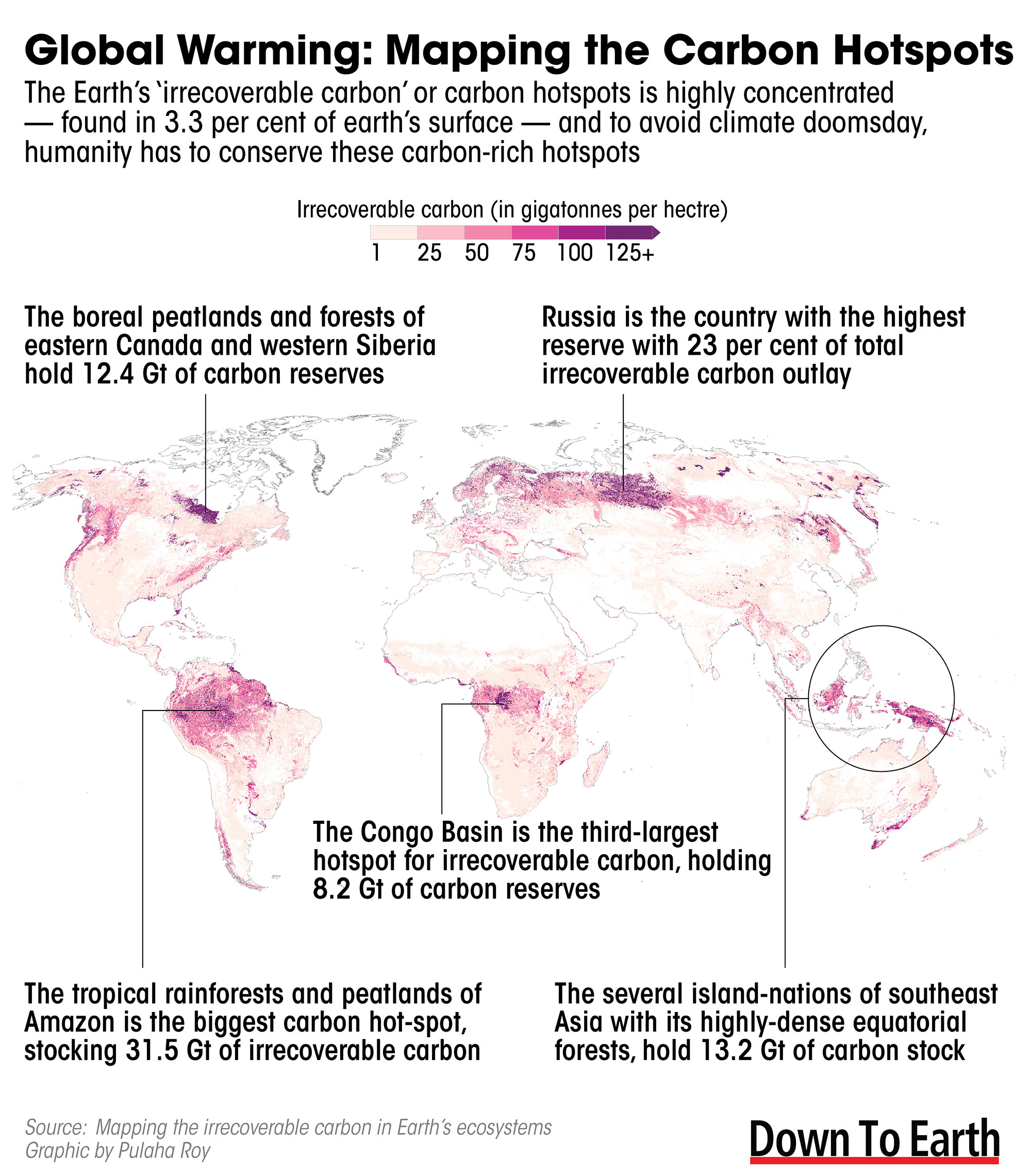Ahmedabad
(Head Office)Address : 506, 3rd EYE THREE (III), Opp. Induben Khakhrawala, Girish Cold Drink Cross Road, CG Road, Navrangpura, Ahmedabad, 380009.
Mobile : 8469231587 / 9586028957
Telephone : 079-40098991
E-mail: dics.upsc@gmail.com

Irrecoverable Carbon
News: Researchers have identified and mapped 139 gigatonnes (Gt) of “irrecoverable carbon” in some of the world’s major forests and peatlands — including the Amazon and the Congo — to avoid catastrophic climate change.
What is Irrecoverable Carbon?
• The concept of ‘irrecoverable carbon’ was introduced in 2020.
• All kinds of ecosystems — lush rainforest, muddy peatland, shady mangroves — contain eons of stored carbon, captured by photosynthesis.
• Per square kilometer, the forests are among the most effective carbon stores in the world; but they’re also some of the most difficult to restore.
• If destroyed, these ecosystems could take decades or centuries to regenerate.
• In other words, the 139 gigatons of carbon contained in these areas are effectively irrecoverable if released due to anthropogenic activities.
• Once released in air, it can be recovered but would take centuries to fully recover or naturally reintegrate.
Latest Study:
• In the new study, researchers have identified and mapped carbon reserves that are “manageable, are vulnerable to disturbance” and cannot be recovered by 2050.
• They held study of peatlands of the Congo Basin and Northern Europe; and in North America, the mangrove swamps of the Everglades and old-growth forests of the Pacific Northwest.
• 2050 has been set as the deadline for taking global carbon emissions to net zero in order for Earth to avoid warming at 1.5-2 degrees celsius above the pre-industrial levels.
• To mitigate such a warming scenario, it is imperative to conserve the ecosystems with 139 Gt carbon.
Highlights:
• Amazon is the biggest carbon sink on earth, holding 31.5 Gt irrecoverable carbon.Brazil has the secondlargest irrecoverable carbon reserves, after Russia that holds 23 per cent of the total irrecoverable carbon outlay in the world.
• The second-largest reserve of carbon, at 132 Gt, comprise the islands of Southeast Asia, with their equatorial rainforests.The Congo basin is the third-largest hotspot of irrecoverable carbon with over 8 Gt of carbon reserves, according to the study.
• Australia, which has become a hotspot for wildfires, is home to 2.5 per cent of the world’s carbon reserve along its coastal mangroves and forests in the southeast and southwest.

Address : 506, 3rd EYE THREE (III), Opp. Induben Khakhrawala, Girish Cold Drink Cross Road, CG Road, Navrangpura, Ahmedabad, 380009.
Mobile : 8469231587 / 9586028957
Telephone : 079-40098991
E-mail: dics.upsc@gmail.com
Address: A-306, The Landmark, Urjanagar-1, Opp. Spicy Street, Kudasan – Por Road, Kudasan, Gandhinagar – 382421
Mobile : 9723832444 / 9723932444
E-mail: dics.gnagar@gmail.com
Address: 2nd Floor, 9 Shivali Society, L&T Circle, opp. Ratri Bazar, Karelibaugh, Vadodara, 390018
Mobile : 9725692037 / 9725692054
E-mail: dics.vadodara@gmail.com
Address: 403, Raj Victoria, Opp. Pal Walkway, Near Galaxy Circle, Pal, Surat-394510
Mobile : 8401031583 / 8401031587
E-mail: dics.surat@gmail.com
Address: 303,305 K 158 Complex Above Magson, Sindhubhavan Road Ahmedabad-380059
Mobile : 9974751177 / 8469231587
E-mail: dicssbr@gmail.com
Address: 57/17, 2nd Floor, Old Rajinder Nagar Market, Bada Bazaar Marg, Delhi-60
Mobile : 9104830862 / 9104830865
E-mail: dics.newdelhi@gmail.com